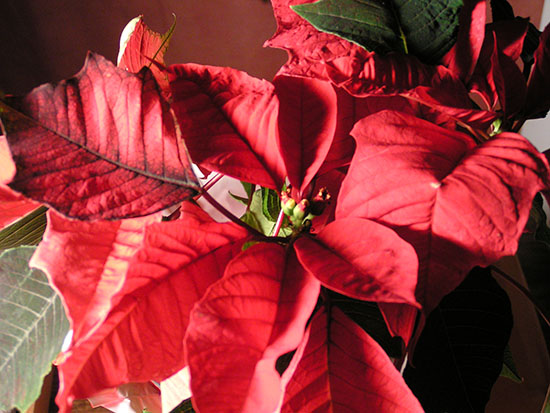Holiday Flowering Houseplants: Poinsettia
It’s December and every time you go shopping – at department stores, grocery stores, big box stores, garden centers – you see poinsettias in full bloom. They make delightful holiday decorations because winter is their natural flowering time. The bright red “flowers” and bright green leaves say Christmas for many people. I put “flowers” in quotes because those big, showy, red “petals” are bracts, modified leaves, not flowers. The real flowers are tiny and insignificant.
In addition to several shades of red, poinsettias now come in an array of colors: white, yellowish, pink, and striped. There are also double-bracted varieties which have a larger number of colorful bracts than the original wild type.
The poinsettia, Euphorbia pulcherrima, is a tropical shrub, originally from Mexico. It adapts fairly well to conditions inside our homes. Put them on a bright, sunny windowsill because they need sunlight to grow well and stay healthy. They can temporarily live in a shady location when you use them for decoration, but put them back in the window. Don’t keep the pot in a saucer full of water because if the roots are constantly wet they’ll get root rot and die. If you live in a mild winter climate you can plant them outdoors in spring. Outdoors they get big, sometimes ten feet tall and six feet wide. Spectacular in full bloom. Remember, hard freezes will kill them.
As houseplants though, the biggest problem poinsettias face is whitefly. Whitefly is a tiny insect that flies up in your face when you disturb the plant. Generally they hide on the underside of leaves where they quietly suck sap out of your plant’s veins. Often, you don’t even notice them until you start to see sticky, glossy honeydew (a euphemism for insect poop) coating the leaves. There can be quite a lot of these insects on your plants before you’re really aware of them. You’ll notice them when you disturb your plant they fly about like a cloud of snowflakes.
Whitefly comes into your home, usually, on infested plants. In mild-winter climates they live outdoors and can come in through open windows or doors. But most often they arrive unseen on plants that were already infested when you bought them. These sneaky little devils get past you because you can’t see their eggs or their babies. You can only see the adults. The babies are microscopic crawlers lurking on the underside of leaves. After the plants are in your home for a few days you might begin to see some adults flying about when you water your plants.
If whitefly shows up on your poinsettias there are several good, non-toxic ways of dealing with them. Don’t automatically reach for a spray can. Remember, these plants are living in your home with you so be careful what you treat them with. It can be extremely satisfying to nail the adults by sucking them into your vacuum cleaner as they try to escape! Whiteflies are weak flyers and a fan will blow them away from your plants. They are attracted to yellow sticky cards — cards covered with goo that traps the insects when they land on it. Trapping and destroying the adults feels good because you feel like you’ve actually accomplished something. But, until you deal with all the babies, these little buggers will be around to haunt you for a long time! Spray the undersides of the leaves with insecticidal soap to kill the crawlers and treat the plants with it every three days. Neem oil, used in the same way, will also work. Both these products are safe to use inside your home but Neem smells bad to some people. With whitefly under control you can keep your poinsettias year after year.




Leave a Reply